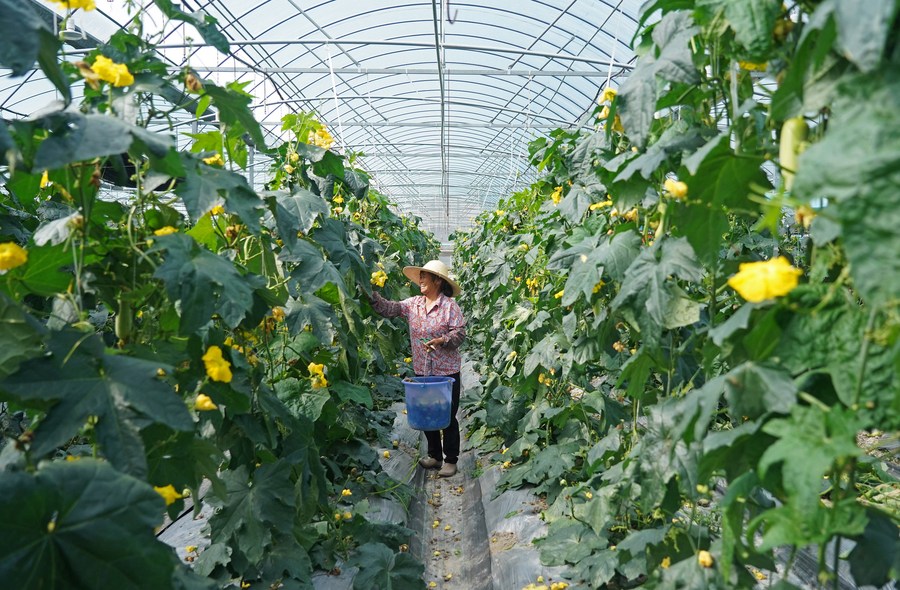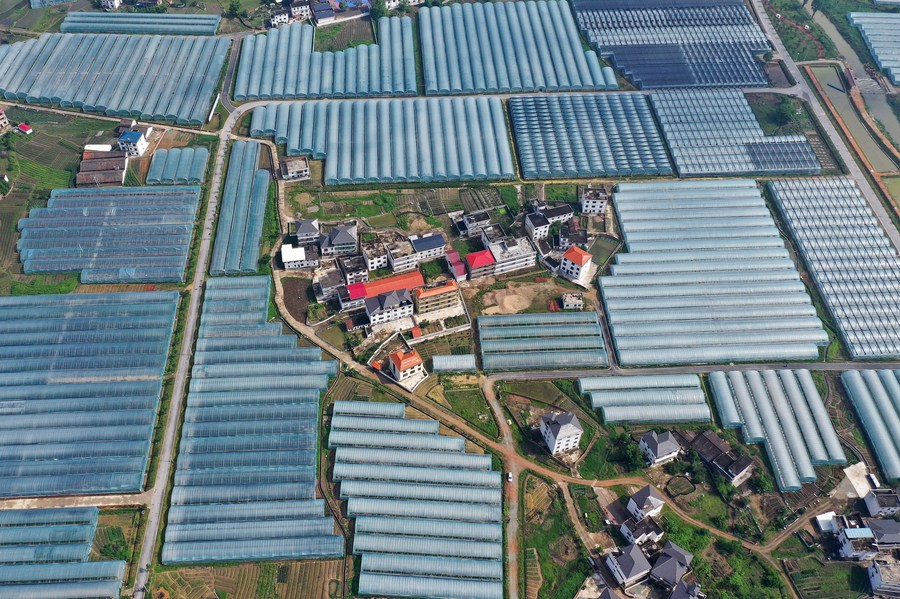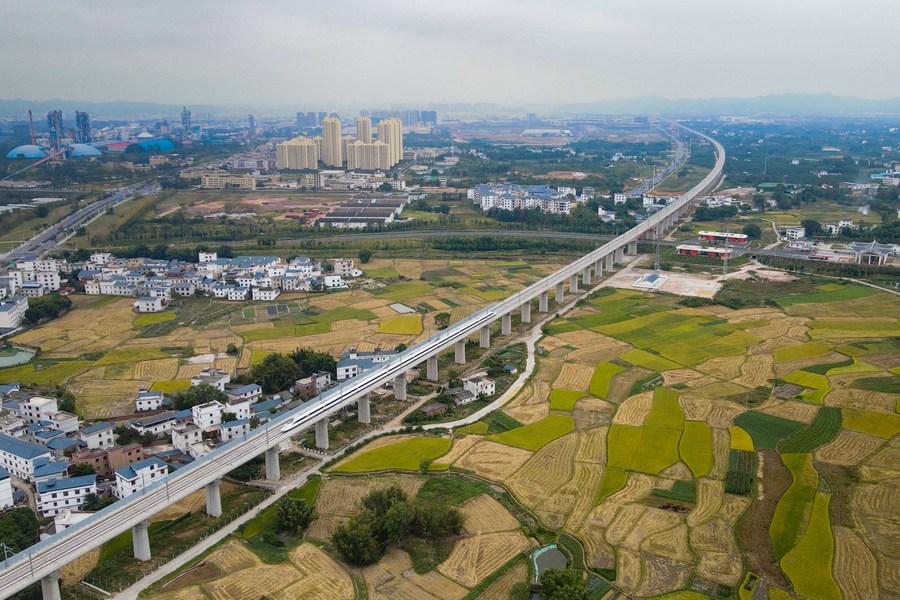10 years on, old revolutionary base embarks on new development path
* Ganzhou City in east China's Jiangxi Province was important in China's early revolutionary activities due to its remote mountain ranges, but the geographical advantage during wartime turned out to be a stumbling block for development.
* Thanks to a development strategy launched by China in 2012 to vitalize old revolutionary bases, the economic development and people's livelihood in Ganzhou City have been greatly improved.
* In Ganzhou City, the output value of the modern furnishing industry topped 200 billion yuan in 2021, and the operating revenue of the textile and garment industry cluster exceeded 100 billion yuan.
By Xinhua writers Guo Yuanming, Cheng Di, Chen Yushan
NANCHANG, July 23 (Xinhua) -- Yuan Jianhong does not need to wear rain boots at home anymore. The 52-year-old resident of Tantou Village in Ganzhou City, east China's Jiangxi Province, had never imagined that she would be able to wear normal shoes to stroll around a lotus pond in her garden-style village.
"In the past, water would flow into the house and seep through the walls on rainy days, so rain shoes were a must in my muddy home," Yuan said.
Yuan attributes the huge improvement in her living conditions to a comprehensive development strategy launched by China in 2012 to vitalize old revolutionary bases, including Ganzhou City, one of the Long March starting points and a place where the Communist Party of China conducted a slew of revolutionary activities.

A villager works in a vegetable greenhouse in Tantou Village of Ganzhou, east China's Jiangxi Province, April 29, 2021. (Xinhua/Wan Xiang)
POVERTY TO PROSPERITY
With rows of buildings and clean cement roads lined with drainage ditches, Tantou Village, located near the Long March ferry, has taken on an entirely new look in the last decade.
"The environment in the village was awful, with only the elderly and children left behind," said Liu Lianyun, Party secretary of Tantou Village.
In 2011, there were still nearly 2.2 million poverty-stricken people in Ganzhou City, where the incidence of poverty was higher than the national average. Approximately 2.4 million people there had no access to clean water, and 71,000 households were short of electricity.
Hope came in 2012, when 21 national-level supportive documents were implemented in the city, helping nearly 3 million farmers in Ganzhou live in safe and comfortable renovated houses. All villages with over 25 households have been paved with cement roads.

Aerial photo taken on April 29, 2021 shows a vegetable and fruit planting base in Tantou Village of Ganzhou, east China's Jiangxi Province. (Xinhua/Wan Xiang)
Tantou Village bid farewell to poverty in 2017. The once foul-smelling cowsheds, pigsties and public toilets were replaced with beautiful squares and new areas where villagers could relax. Dilapidated houses, drinking water shortages, damp walls and other problems that had plagued villagers for generations have all been resolved.
Meanwhile, comprehensive strength has achieved great leaps in the whole Jiangxi Province through vigorous implementation of the primary strategy of high-quality and leap-frog development.
Over the past decade, Jiangxi's gross domestic product has grown at an average annual rate of 8.4 percent and its growth rate of major economic indicators continued to maintain a leading position in the country.
DEEP MOUNTAINS TO THE WORLD
In Shanqi Village, vegetable greenhouses stretch all over the mountains in the summer, and farmers are busy in the fields.
Located in Ruijin, a county-level city under the jurisdiction of Ganzhou City, Shanqi Village has promoted rural vitalization through the vegetable industry in recent years.
A vegetable wholesale market with cold-chain logistics and an e-commerce industrial park were established in 2020, bringing more jobs to locals and increasing the annual average income of villagers by nearly 20,000 yuan (about 2,960 U.S. dollars).

A visitor takes photos of furniture exhibits in Ganzhou, east China's Jiangxi Province, Feb. 18, 2022. (Xinhua/Wan Xiang)
The main business income of the digital economy in Ruijin is expected to exceed 5 billion yuan this year. In Ganzhou City, the output value of the modern furnishing industry topped 200 billion yuan in 2021, and the operating revenue of the textile and garment industry cluster exceeded 100 billion yuan.
Poor infrastructure construction once constrained the development of the old revolutionary base, but now a complete transportation network has allowed Ganzhou to embrace more opportunities.
The Ganzhou international inland port connects the old revolutionary base with more than 150 cities in 22 countries and regions. At the end of last year, the Ganzhou-Shenzhen high-speed railway brought China's tech hub of Shenzhen closer than ever, shortening the travel time to under two hours.

Aerial photo taken on Oct. 14, 2021 shows a bullet train running for trial on a grand bridge along the Ganzhou-Shenzhen high-speed railway, in Xinfeng County of Ganzhou, east China's Jiangxi Province. (Photo by Zhang Haigen/Xinhua)
Though suffering amid the COVID-19 pandemic, Jiangxi Rui'en Industrial Co., LTD., based in Ganzhou City, sends three to five containers loaded with furniture to Europe, Southeast Asia and other regions every week.
"Enterprises in the old revolutionary base can enjoy the same transportation costs, customs clearance processes and other services as those in the coastal cities," said Luo Liangbing, chairman of the company.
(Xinhua reporter Zhu Yunuo also contributed to the story.)
(Video reporters: Guo Yuanming, Cheng Di, Chen Yushan and Li Zongyin; Video editors: Zhang Yucheng and Li Qin.)
Photos
Related Stories
- China's Global Development Initiative vital for least developed countries: Cambodia's top diplomat
- China enjoys high-quality development in past decade
- Global Development Initiative: a Chinese answer to the questions of the times
- Interview: CEO says China to leapfrog in technology development
- All-around development of Chinese children guaranteed
- SW China's Guizhou promotes big-data industry as backbone of high-quality development
- Highlights of China's economic development in past decade
- NW China's supporting policies help boost innovation, high-quality development
- Surging offshore wind power boosts China's green development
- How China's experience boosts Africa's sustainable development
Copyright © 2022 People's Daily Online. All Rights Reserved.









